The Definitive Neumann KH 120 Review
Are these the most accurate studio monitors available for the home studio?

Reviewed by: Paul Narang
Review date: April 2023
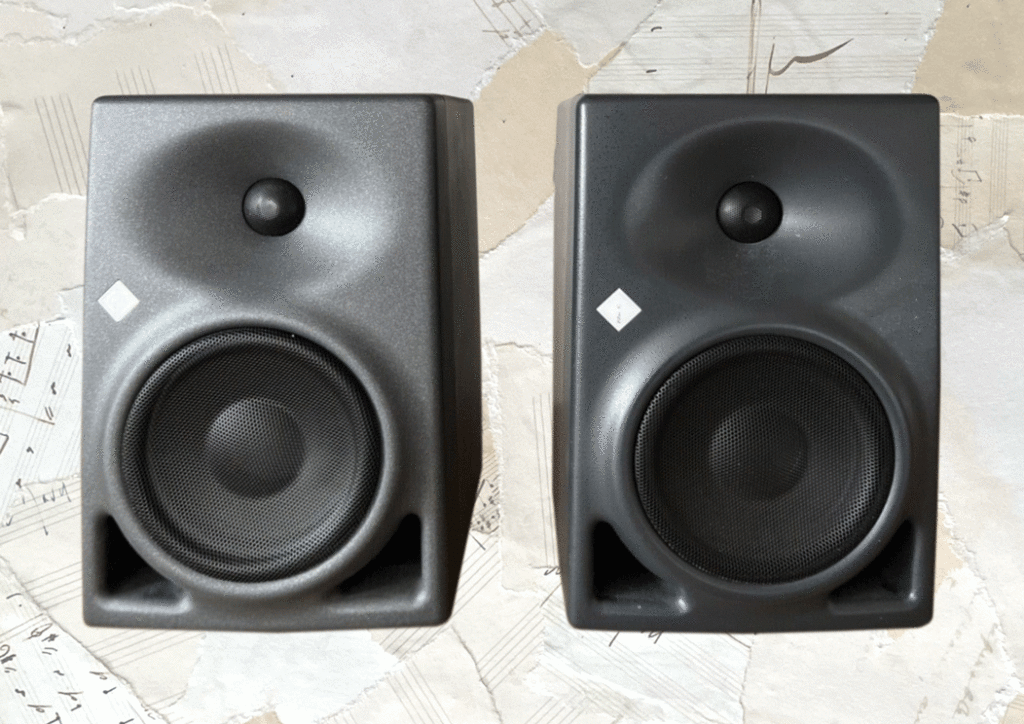

Neumann KH120 Review
| Pros | Cons |
| Extremely clear and neutral sound Great dynamics & transient reproduction Front-ported | Bass only extends to 52Hz Pricey |
Neumann KH 120 A Review
Neumann have a reputation for making premium microphones. With the KH range they bring the same exceptional sound quality to the studio monitor market.
The Neumann KH 120s are designed specifically for small rooms, and offer neutral, faithful sound reproduction. Aimed at those with a higher budget, they’re one of the best reference monitors in their price class.
What are they?
Founded in Berlin in 1928, the Neumann brand is well known for making exceptional quality microphones, and other premium electronics. More recently Neumann has partnered with Klein and Hummel – another German manufacturer with a long-standing reputation for producing premium quality speaker systems. Together they’ve produced the KH range of active nearfield studio monitors.
The KH 120s are a compact unit ideal for the smaller control room. They have 5.25” woofers, with 50W drivers for both woofer and tweeter. The KH120s are active, meaning they require mains power, but don’t require an external amplifier. They’re also bi-amped – they have two separate dedicated amplifiers to power both the woofer and tweeter.
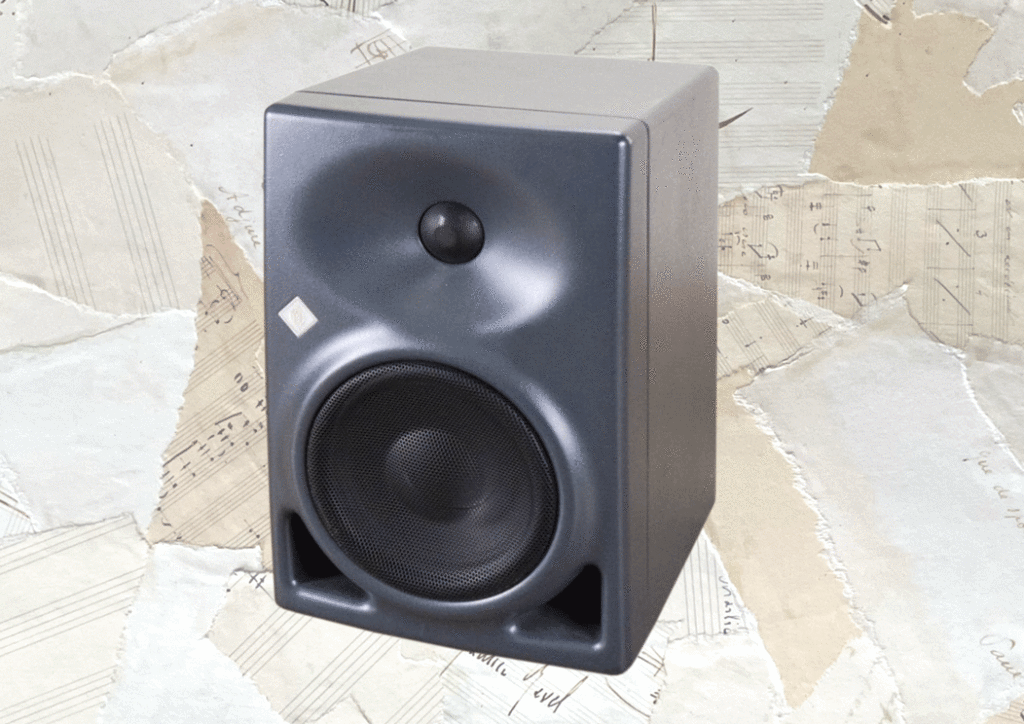
The Neumann KH 120s have a good low-range for their size, extending down to 52Hz -thats the G# 2 1/2 octaves below middle C. They’re capable of pumping out sound at impressive volumes of up to 111.1dB.
All together, the 120s are perfect for small rooms or more intimate monitoring situations. I think it’s fair to say they’re widely known for a detailed and neutral sound. This is what I look for in monitors – it means that they’ll accurately recreate your mixes, warts and all!
If you have the budget for quality monitors, or are currently looking to upgrade, the KH120s may well be the right choice for you. Let’s see how they perform in this Neumann KH120 review.
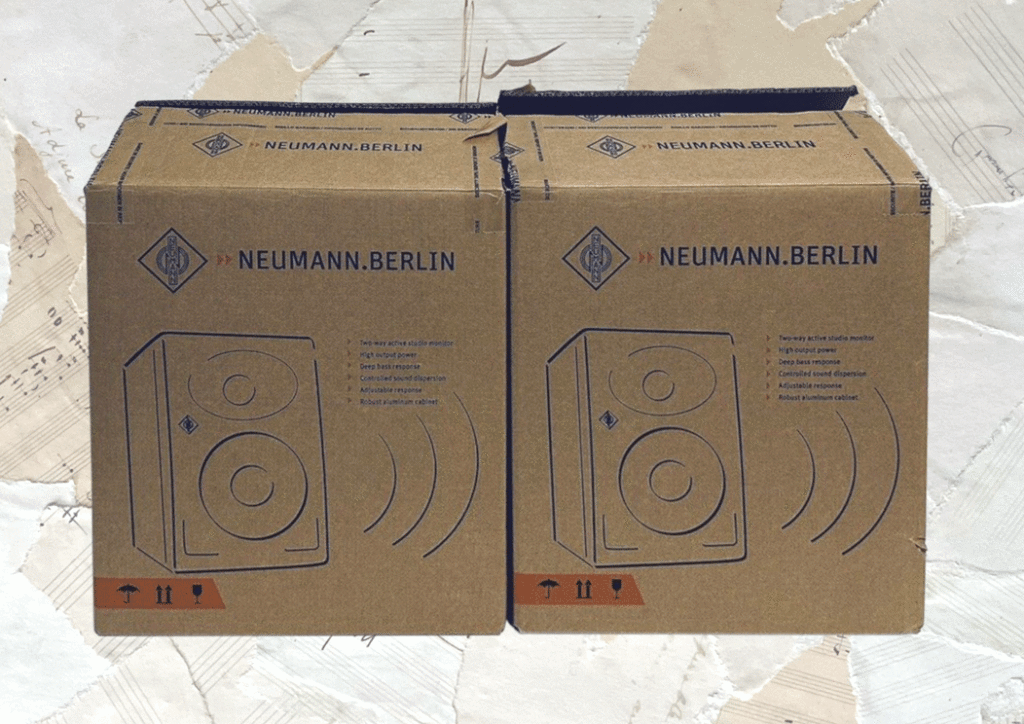
In the box
The KH120s are sold separately. In the box you’ll find:
- 1 x KH 120 A Studio Monitor
- 4 x Self adhesive feet
- 1 x Mains Cable UK
- 1 x Safety Guide
- 1 x ‘Getting Started Quickly’ Guide
KRK Rokit 5 G4 Controls
All the controls for the speaker are tucked away on the rear side of the unit. You’ll find 3 Acoustic EQ controls (1), each with accompanying diagram and descriptions:
- low shelf
- low-mid band
- high shelf
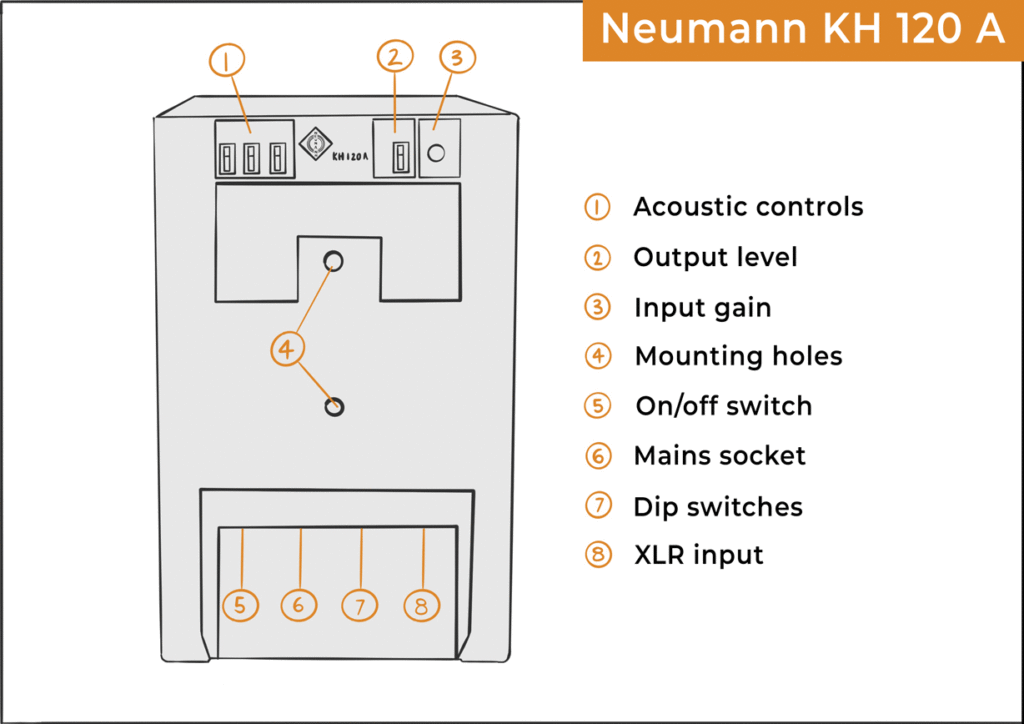
There’s also an output level switch (2), which can set the maximum volume of the speaker. Here you have four options: 94, 100, 108 or 114 dB SPL. This is useful in calibrating your speakers to an appropriate level for your room: if you have a smaller studio you can often mix at lower volumes, but you may find that the volume on your interface is set very low to accommodate this. In this situation it can be useful to set your monitors to a lower max SPL instead.
In addition to this, there’s also an input gain knob (3) which can alter the level of each speaker individually down to -15db. This is particularly useful when setting the correct balance between both speakers for an accurate stereo image.
There are 3 more DIP switches (7) towards the base of the unit, as well as a power switch:
- The on/off switch for the illuminated Neumann logo
- A brightness selector for the logo
- A ground-lift switch, which is used to cut out the electrical noise produced by the earthing in audio cables.
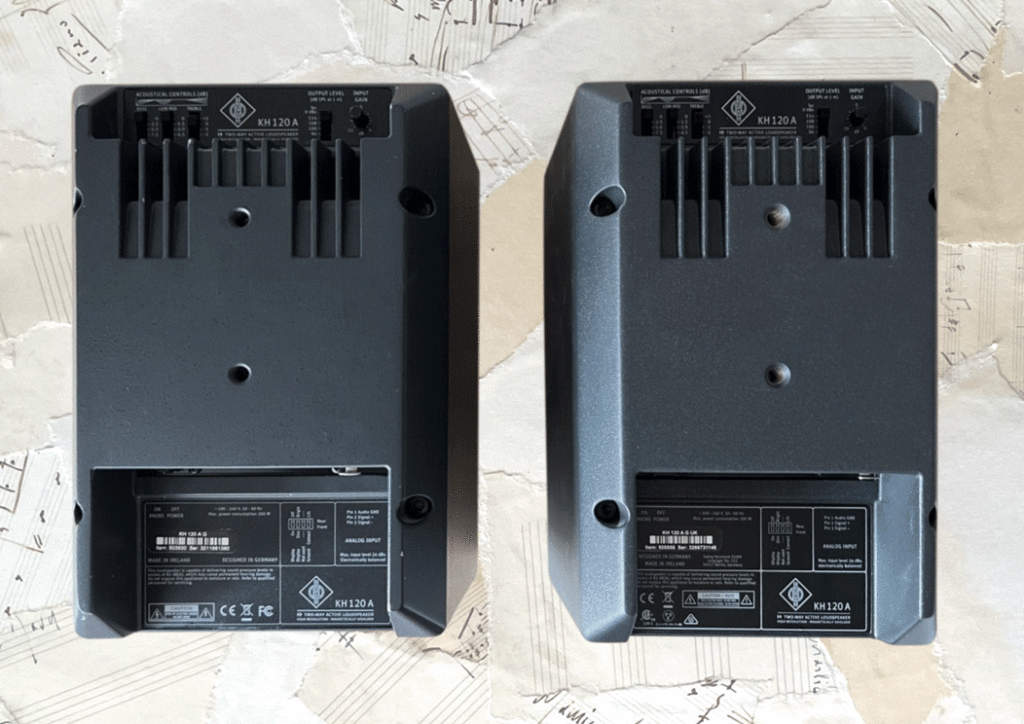
Neumann KH 120 Equalisation options
The Neumann KH 120s have 3 different EQ switches, each with 3 settings. This is invaluable for small or untreated rooms, as you can tweak the sound of the monitors to suit the shape of the room.
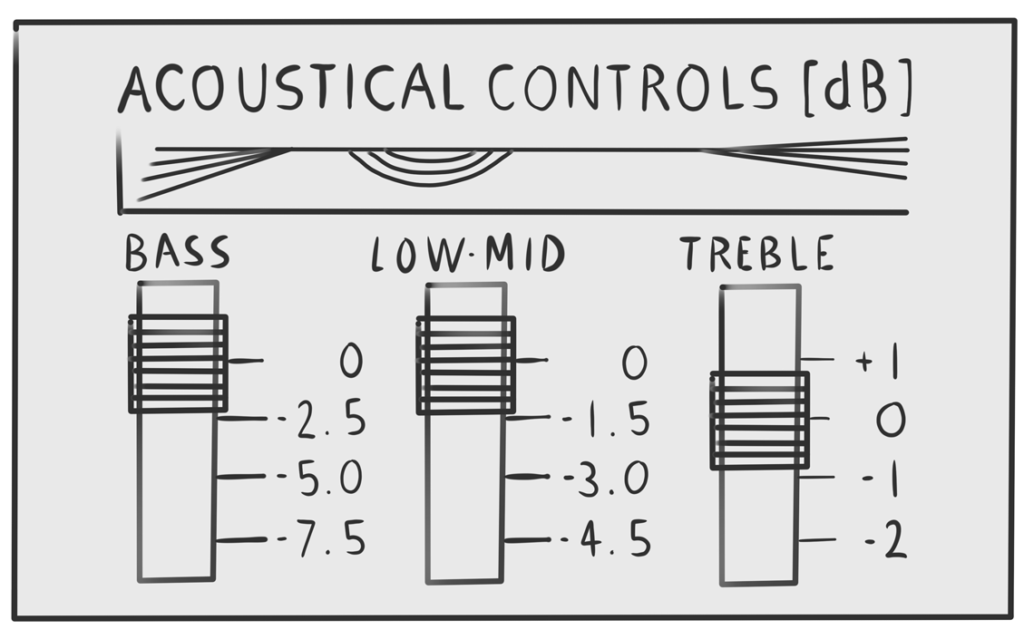
- Bass filter
This is a low-shelf filter which affects all the frequencies below about 400Hz. The bass filter is useful for reducing boominess, particularly if your speaker is positioned close to a wall. It can be adjusted to 0dB, -2.5dB, -5dB or -7.5dB.
I left this at 0dB while testing in an acoustically treated room, as activating the low filter reduced too much bass. But it is a really useful feature that I’d probably use if I had to take the monitors out on location, or if I had to position them right up against a wall.
- Low-Mid filter
This is a wide-band filter which affects a range between about 60Hz and 1.5kHz. The low-mid filter addresses a range which can be responsible for “muddiness”. This can be set at 0dB for zero effect, or reduced by -1.5dB, -3dB, or -4.5dB.
I left this on 0dB, but wouldn’t hesitate to activate the filter if placing the 120s on a desk, to remove some of those early reflections.
- Treble filter
This is a high-shelf filter which affects all the frequencies above 5kHz. The treble control allows you to customise the brightness of your speakers to your particular taste. They can be set to -1db, -2db, 0dB or +1db.
Again, I had these set at 0dB, which sounded natural to me. But I’d need to listen over an extending period of time before deciding to make any adjustments.
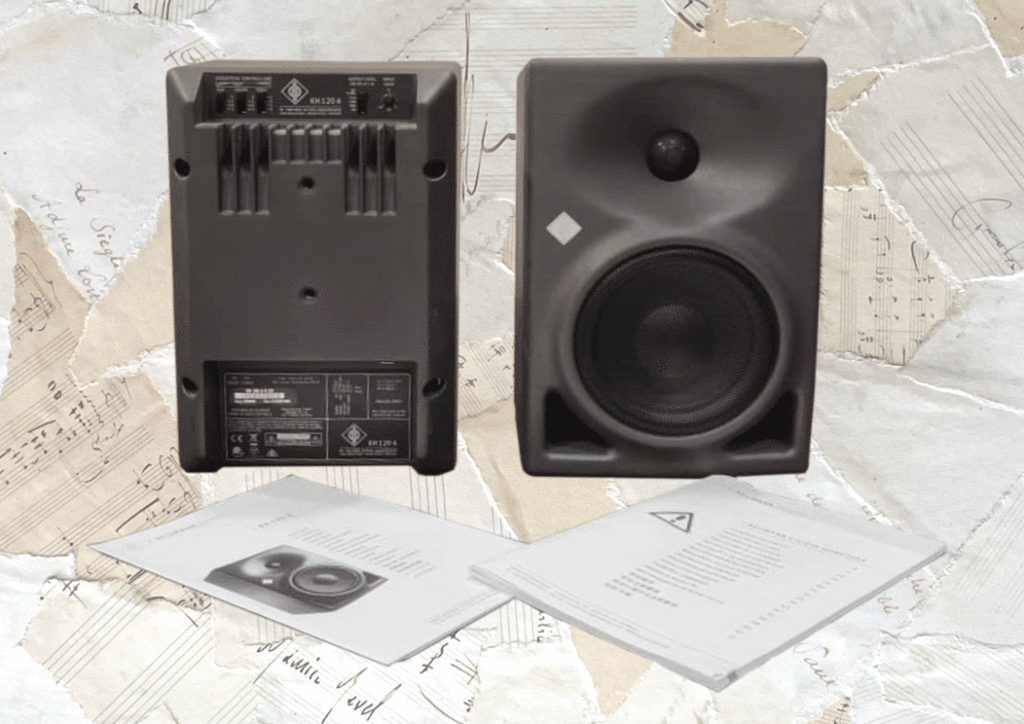
Input connections on the Neumann KH 120 A
The audio inputs on the Neumann KH 120 As are nice and simple – one balanced XLR input on the back-panel of the unit. While this may feel limiting for some, a balanced XLR input is the industry standard for premium-level studio monitors.
Depending on your setup, there are various options for connecting up your speakers.
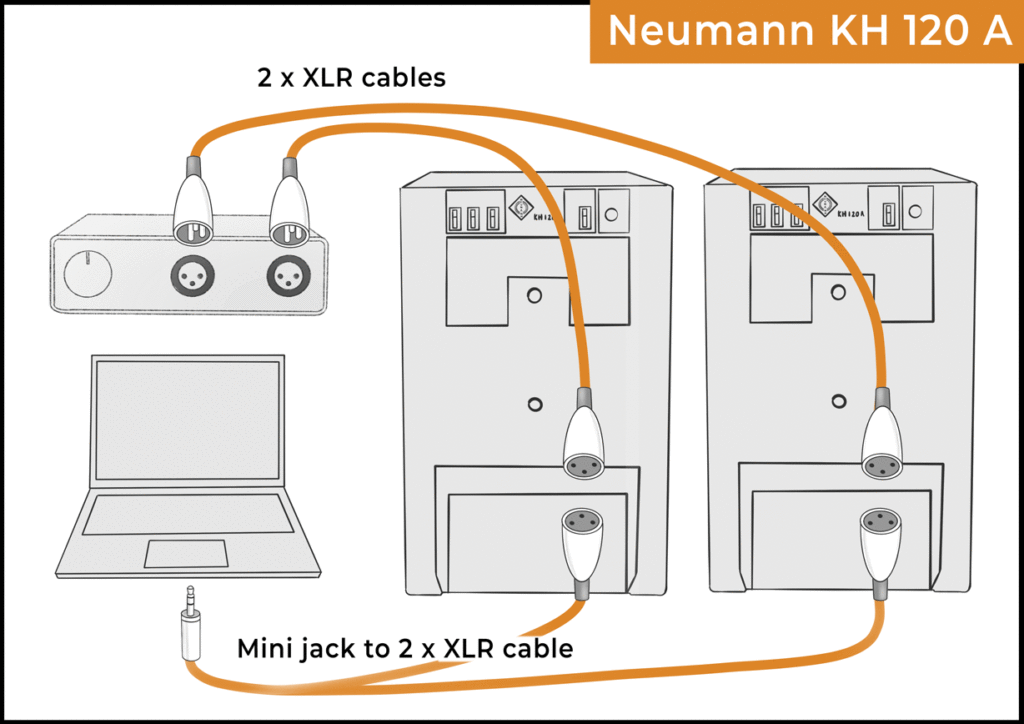
Connecting the Neumann KH120s to an audio interface
Many professional audio interfaces have a pair of stereo XLR outputs (one for the left channel, one for the right). If you have one of these, you can simply use two balanced XLR cables, one running to each speaker.
However, some of the smaller audio interfaces have a pair of ¼” TRS outputs. Connection is also straightforward here – use a pair of balanced ¼” TRS to XLR cables.
Connecting the Neumann KH 120 A without an audio interface
If you’re not planning to use an audio interface, it’s likely you’ll be connecting via the stereo headphone output of your device. This would be the case for connecting to a laptop or iPad tablet, or phone.
You’ll need a stereo 3.5mm TRS to twin XLR cable. If one of these isn’t available, you can use a ¼” Stereo TRS to twin XLR cable with a 3.5mm to ¼” jack adapter.
If you want to connect to a hifi with phono outputs, you’ll need a pair of phono to XLR cables, which are widely available.
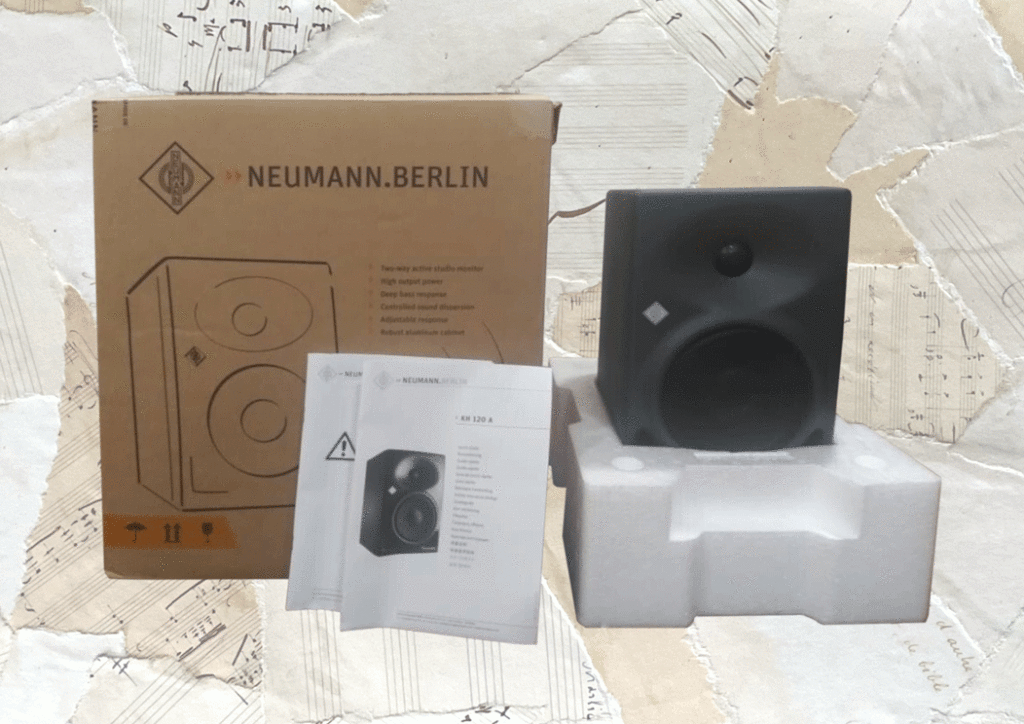
Does the Neumann KH 120 have bluetooth?
Unfortunately, the 120s don’t have bluetooth connectivity. But if wireless connectivity is important for you, you can buy a bluetooth receiver, and connect it to the inputs of the monitors with cables.
Bear in mind though, for professional use, a bluetooth stream will never match the quality of using cables.
Neumann KH 120 A – Construction and design
On first impression, the KH 120 has a strikingly sleek and minimalist design, with beautiful matte grey curves. Despite the simple, pared-back look, the features are surprisingly extensive.
The Neumann 120 is extremely durable, with a sturdy aluminium casing. Not only are the flowing curves of the front plate aesthetically pleasing, they also have a functional purpose.
Around the tweeter you’ll find the trademark MMD™ (Mathematically Modelled Dispersion) waveguide. A waveguide helps to influence the direction of the sound within the room. It helps match the woofer and tweeter by guiding the sound-waves, aiding in separation and avoiding phase issues.
The waveguide also helps to create a wide sweet spot (ie. a listening position where you can move your head around and still get the best sound). I found the sweet spot on the Neumann KH120s to be quite wide along the horizontal plain, with enough room to move from side to side. Vertically it was a little narrower, designed to reduce nearby surface reflections.
The soft curved edges and corners of the casing also have the function of reducing reflections from walls, tables, or anything in the environment.
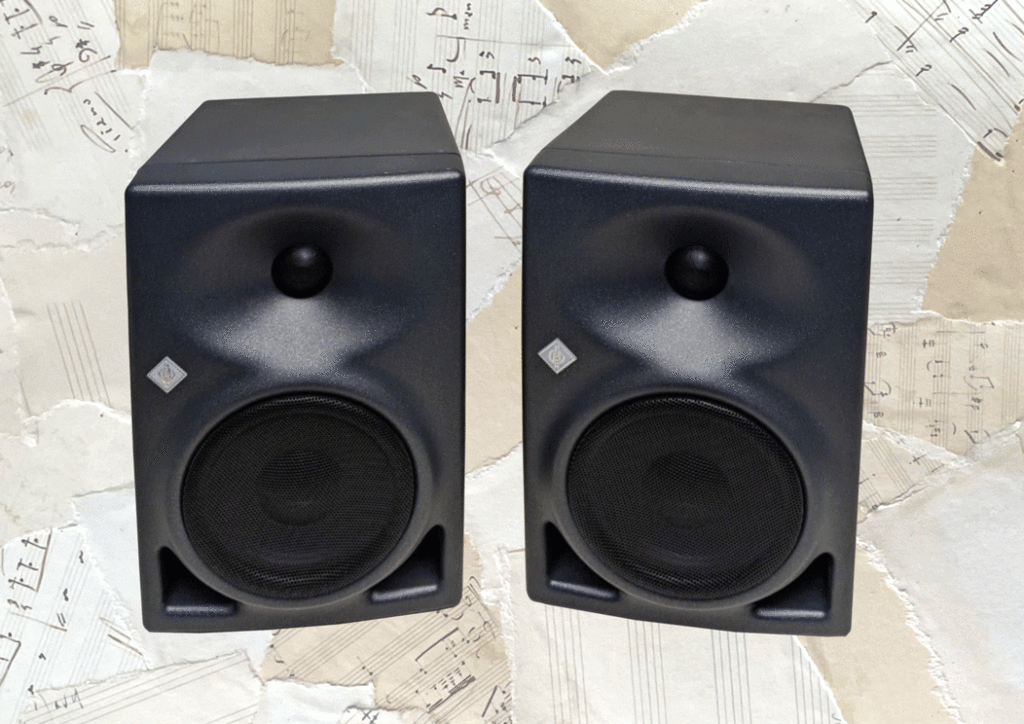
The Neumann KH 120 is front ported – a port is a tunnel and opening, releasing bass frequencies from inside the cabinet. Having this placed on the front, rather than the back adds some flexibility with speaker placement, allowing them to be placed nearer to walls.
There’s some great attention to detail in the design – the LED logo on the front is illuminated, and it can be dimmed or switched on and off. It will also turn red if the input of the speaker is being overloaded and the speaker’s internal protection system has been activated.
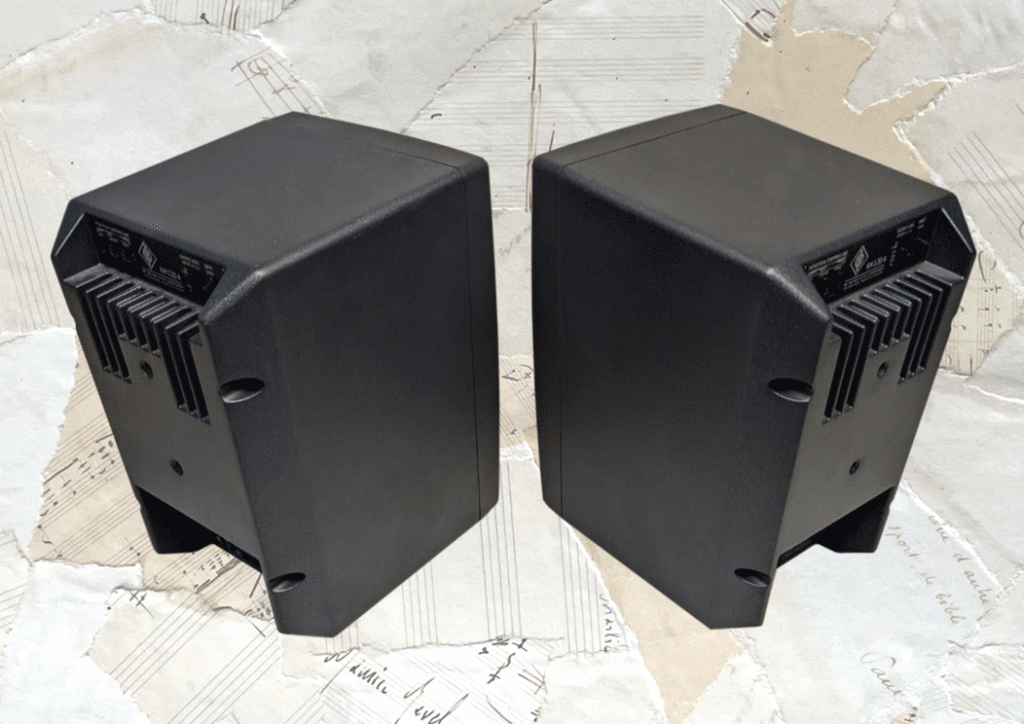
The rear of the cabinet has a pair of 8mm threaded holes to allow attachment to a wall bracket. Neumann produce a number of compatible accessories to allow for different installation possibilities.
The woofer and tweeter are protected by durable metal grilles, which will come in handy if you’re planning to move them around. Overall the Neumann KH 120 A is a speaker that is stylish and durable with an incredibly precise acoustic design.
Neumann KH120 – Woofers, tweeters and amplifiers
The Neumann KH 120 has a bi-amped design – each woofer has its own dedicated amplifier circuitry. The low and mid frequencies (up to 2kHz) are reproduced by a ‘composite-sandwich’ 5.25” woofer. And the higher frequencies are reproduced by a titanium-fabric 1” tweeter.
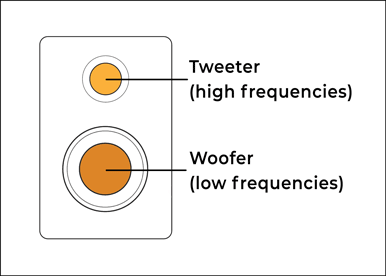
Both the woofer and the tweeter are driven by a pair of 80W Class-A/B amplifiers. This type of amplification is a great choice for both energy performance and sound fidelity. Each amplifier has its own fast acting thermal-protection circuitry which protects the internal components from damage if the circuit gets too hot at high input levels.
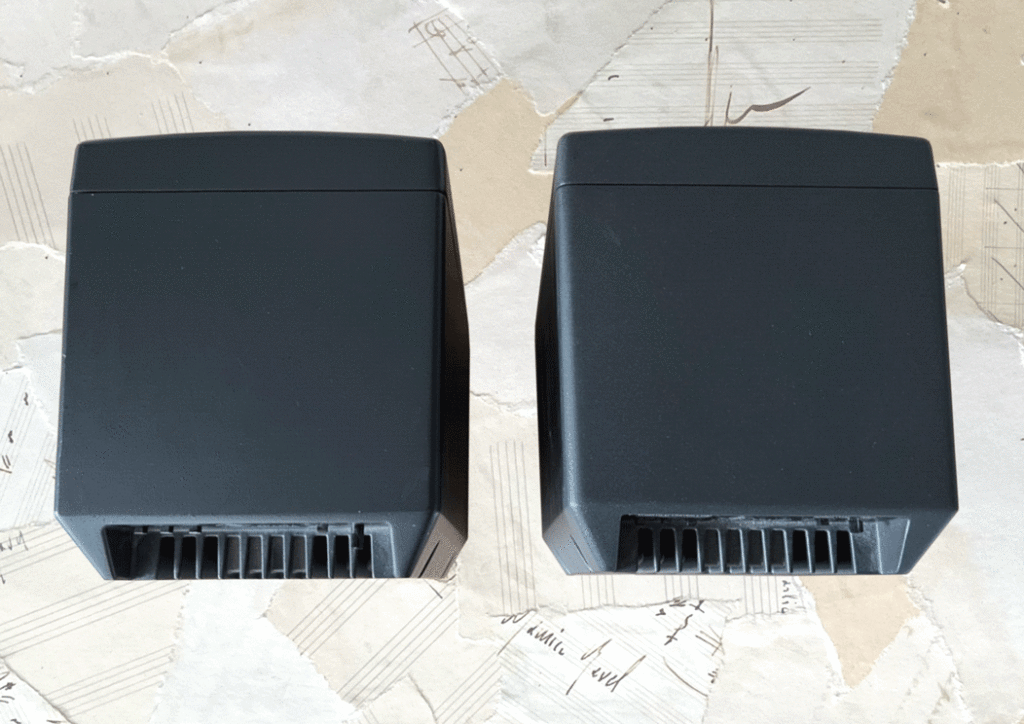
The crossover frequency between the woofer and tweeter sits at 2kHz. In some monitors, you can hear the crossover, but I found the transition between the two drivers to be impressively smooth. There seems to be a truly flat and even response throughout the mid-range.
The woofer also has what Neumann call ‘soft clip and excursion limiters’ which should step in to prevent overload if the input level is too high.
Height and weight
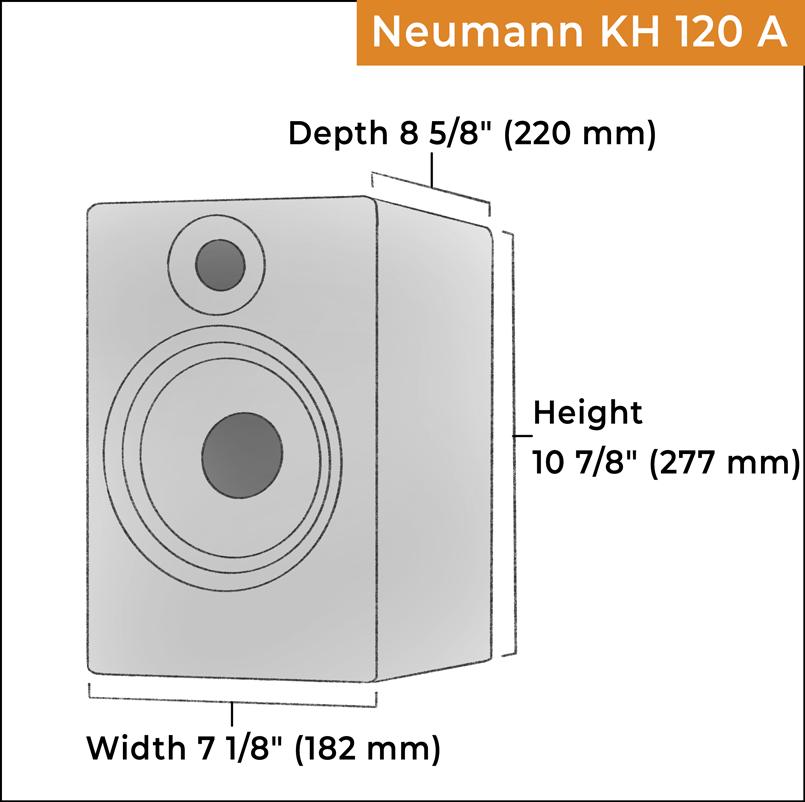
The dimensions of each Neumann KH 120 are:
- Height 10 7/8″ (277 mm)
- Width 7 1/8″ (182 mm)
- Depth 8 5/8″ (220 mm)
- Weight 13.7 lb (6.2 kg)
Neumann KH 120 Frequency response
One of the most striking things about the Neumann KH 120 A is its frequency response. Neumann is so confident about how well these monitor speakers perform, that it publishes its own analysis and measurement diagrams on its website. This isn’t something you’ll often see for a speaker manufacturer.
The 120s have a frequency response from 52Hz – 21kHz. One thing that really stands out about these monitors is just how flat the frequency response is. Looking at the chart, the low-range very gently climbs up to 60Hz, and above this, there’s very little deviation.
Inevitably there are some contours and peaks across the frequency spectrum, but they do not deviate from the a straight line by more than a dB or two, which is a very impressive performance for any speaker.
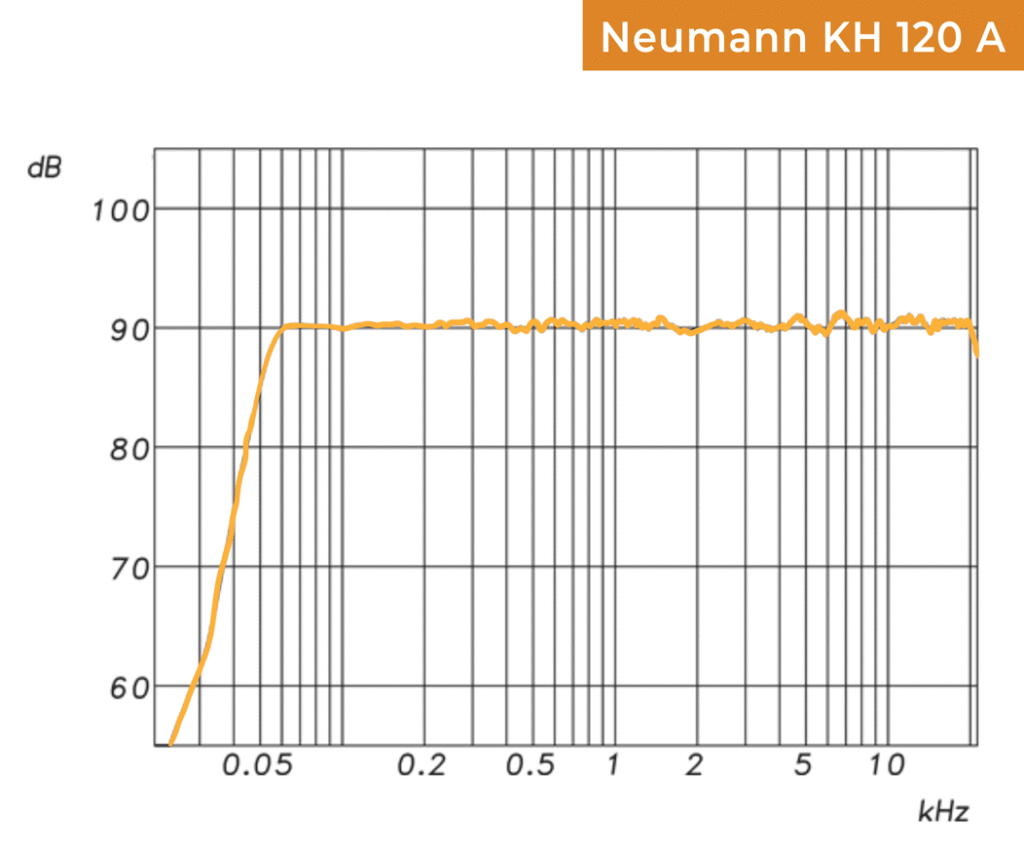
Spectral decay charts do reveal a small amount of port-resonance at about 60Hz, but this is inevitable for most ported monitors. It was something that certainly wasn’t obvious while testing. Remarkably, there are no significant boosts or dips at 2kHz, which is the crossover point between woofer and tweeter.
The advantage of having studio monitors with such a flat response is being able to trust them. It’s so important to hear an accurate representation of your music across the whole frequency spectrum, and that’s exactly what the KH120s provide.
It means that if your mixes have issues, you’ll easily be able to spot them and correct them. When your mixes sound right, you’ll know, and more importantly, when they don’t, you’ll get a chance to correct them before they reach someone else’s sound system.
Where to place your Neuman KH120 monitors
In order to get the best possible sound out of your Neumann KH 120s, it’s a good idea to think carefully about how to position them in your room.
For optimum sound, it’s also worth considering whether you can improve the acoustics of your space. I always recommend that you equip your studio with basic acoustic adjustments such as corner and side absorbers. This makes extra sense when you’re considering monitors with the accuracy and calibre of the KH 120s.
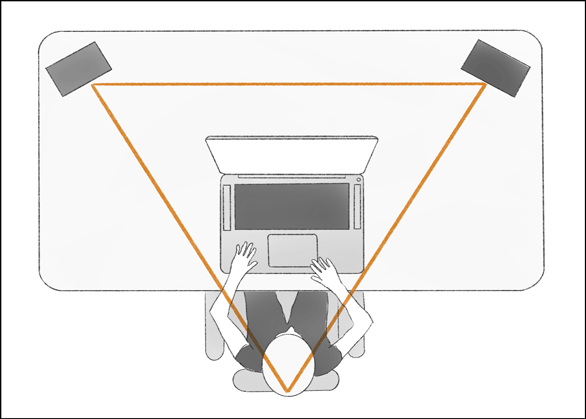
Neumann have some specific recommendations for setting up the KH 120s to get the best possible sound from them:
- Establish a listening position of 1m – 2m from the monitors
- Avoid placing the speakers between 0.8m and 2m away from the back wall to reduce dips in the low frequencies
- Place the speakers at a 30 degree angle, forming a triangle between the listener and the two monitors
- Creating a straight line between the listener’s ears and a point halfway between the woofers and the tweeters. You can achieve this either by placing the speakers at ear-height, or by angling the speakers up or down to face the listener.
When setting up nearfield studio monitors, I’d also recommend positioning them along a narrower wall, so they fire lengthways down the room. It’s always a good idea to also place the speakers symmetrically in the centre of the room, so that they’re an equal distance from the side walls on the left and right.

Performance
The Neumann brand comes with a certain reputation, as does Klein and Hummel. With these brands we’ve come to expect premium build quality and excellent sound. We can see how good they look on paper, with a flat frequency response and a host of EQ controls. But do the Neumann KH 120s live up to the hype in the studio?
On testing, it’s a resounding yes. The bass end is full and detailed, without being hyped or over-inflated. There’s impressively little ‘overhang’ from the bass frequencies too. This means that percussive sounds in the low frequencies decay rapidly, and don’t take too long to die away – a problem I’ve found on many other speakers.
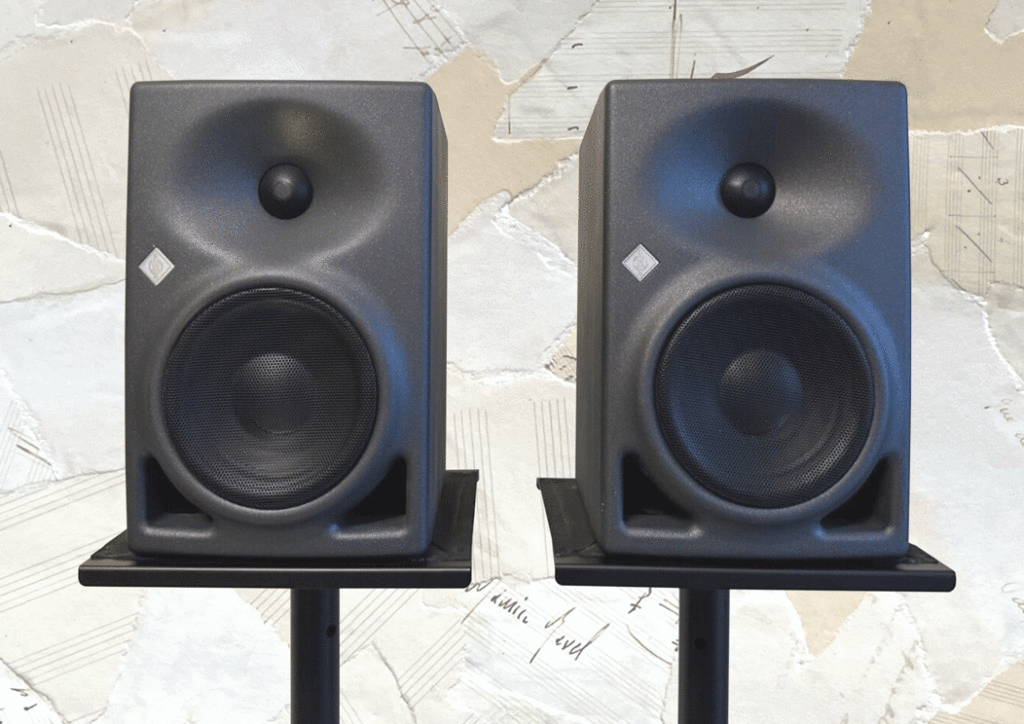
The midrange is extremely flat and honest, and the higher end feels sparkly and airy without ever being too bright. Overall, the frequency spectrum sounds even and clear, with detailed and natural dynamics. To my ears, the sound is reproduced entirely free from harmonic distortion throughout the frequency spectrum.
The stereo image has an impressively wide sweet spot. I was free to move my head from side to side without noticing any changes. Percussive textures were also extremely clear and detailed.
Verdict: The best budget home studio monitors?
At over $500 per monitor, the Neumann KH 120s won’t be within everyone’s budget. However, if you’re looking for high quality sound, and are willing to to spend a little more than average, the 120s are a solid choice for your consideration.
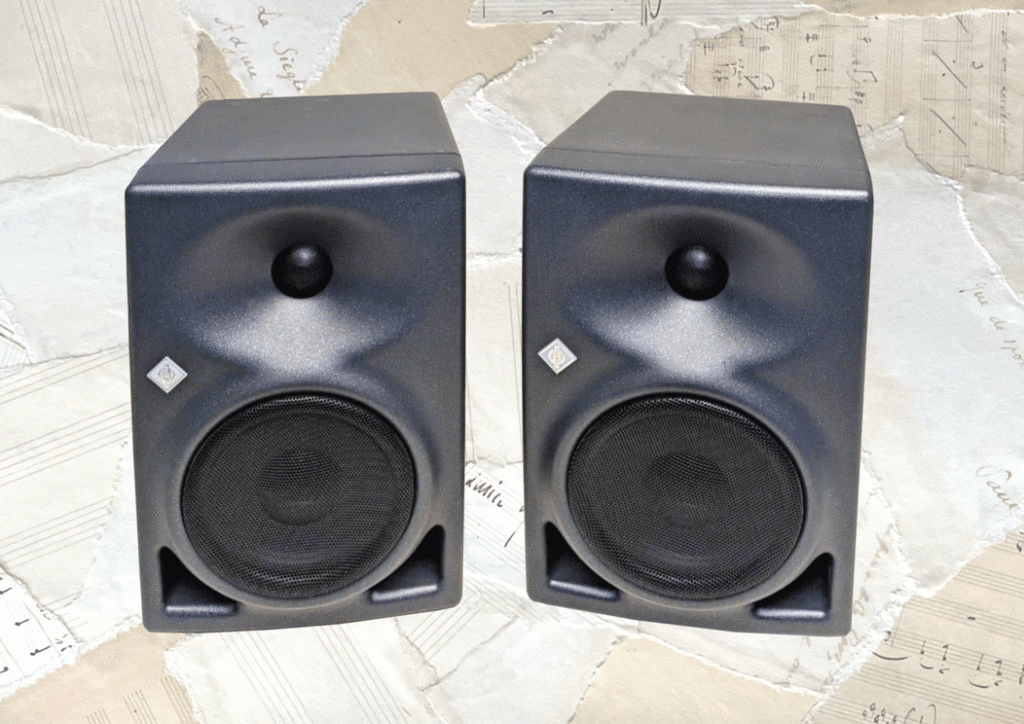
For this price you’ll get the premium electronics and build quality that Neumann is known for. The design of the KH 120 combines carefully chosen amplifiers and drivers with a durable aluminium casing. Internal overload protection systems, and thermal limiting gives you the protection you need in a professional environment.
The smaller size of the woofer may not be enough to fill larger spaces, but they’re an ideal choice for smaller control rooms.
For me, the Neumann KH 120s really shine in one department, and that’s the sound. They demonstrate exactly what I look for in nearfield studio monitors: flat, detailed, honest, neutral performance.
With careful placement and configuration, I think you can trust the KH 120s to faithfully reproduce your mixes. On these monitors, good mixes will sound good, and bad mixes will sound bad!
Need more bass?
One of the limitations of the Neumann KH 120 A, is that the bass response only goes down to 52Hz. For producing more bass-heavy genres of music, you may wish to pair your monitors with a subwoofer.
The Neumann KH 750 DSP subwoofer is designed to be used with a range of Neumann nearfield monitors, including the KH 120. This subwoofer has a 10” woofer and a bass extension down to a bone-shaking 18Hz!
One exciting feature of the Neumann KH 750 is that it can be used in conjunction with the Neumann Control app. This is handy for helping you position, align and calibrate the subwoofer, and connected nearfield monitor speakers.
A series of other KH range speakers can also be connected to the subwoofer to create a high-quality 5.1 system for home cinema. Something to consider if you plan to get into surround sound mixing in the future.
Other models in the Neumann range
Neumann offers an extensive range of monitors under the KH name. Some of these are only found in professional recording studios, but others cross over into the home studio market.
Here’s some other models worth considering if you are looking at the KH 120 A:
- KH 120 A W – the same speaker but in white
- KH 120 A II – an updated version of the 120 A with an extended bass response (down to 44Hz), and higher SPL. It also uses DSP technology for phase linear crossovers between woofer and tweeter, and to help you with room alignment using Neumann’s specialist software
- KH 80 DSP – a smaller model with a 4” woofer and digital signal processing
- KH 150 – a larger version of the 120 A with a 6.5″ woofer, deeper bass (39Hz), and DSP technology for improved performance and room alignment
- KH 310A – a larger, tri-amped monitor with an even deeper bass response (34Hz)
With the exception of the KH 80 DSP, most of these models are more expensive than the KH 120 A, with the larger speakers often retailing for over $1000 per unit.
The KH 120 A remains the best value for home studios, and are relevant if you need high very high accuracy and sound quality.
Neumann KH 120 A vs Genelec 8030C
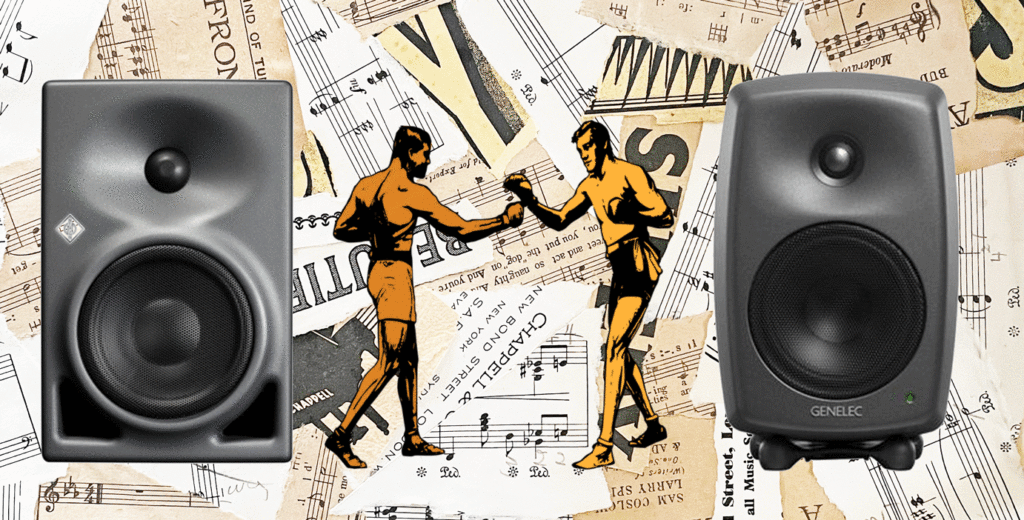
A very popular studio monitor in the same budget range is the Genelec 8030C. Since 1978, Genelec have built a reputation for uniquely designed, high quality reference speakers. Most recognisable is the 8000 series, with its trademark curved steel enclosure.
So how does the Genelec 8030C compare to the Neumann KH 120 A?
Firstly, there’s a lot that the two speakers have in common. They’re both of a similar size, with a 5” woofer (or 5.25″ inches for the Neumann), and woofers and tweeters outputing 50W of power.
They also have a similar frequency range, with the Neumanns extending slightly lower than the Genelecs ( down to 52Hz vs 54Hz). They are also both known for a flat, uncoloured sound, ideal for mixing. Both are active studio monitors, in a similar price range, although the Genelecs are slightly cheaper.
These are both great speakers so it’s really hard to say which one wins this comparison. Though having said that, there are a few details which may have an impact on your decision.
The Genelec 8030Cs are rear-ported. Whilst this can be an advantage in some situations, it means that placing them flush against a wall risks creating unwanted bass resonances.
The Genelecs also have a slightly higher crossover frequency between woofer and tweeter. The Neumanns crossover at 2kHz, whereas the Genelecs crossover at 3kHz. But what does this mean? Crossover points between the woofer and tweeter are generally the weakest point of any monitor. So there’s the potential of the Genelecs to have a weak spot at 3kHz, and for the Neumann’s at 2kHz.
Ultimately, your choice will come down to personal preference. Whilst on paper both speakers offer a very flat response, I find the 8030Cs to be more “forward” sounding in the mid-range. In contrast, the KH 120s are extremely detailed and neutral throughout the spectrum.
The bass range of the Genelec 8030C also rolls off from a little higher than the Neumanns (around 80Hz instead of 60Hz), which gives the Neumann 120s a bit more presence in the low end.
Both of these speakers are a great choice, but for me, the Neumann is the winner when it comes to neutral, dynamic mixing.
Neumann KH 120 A vs Neumann KH80 DSP
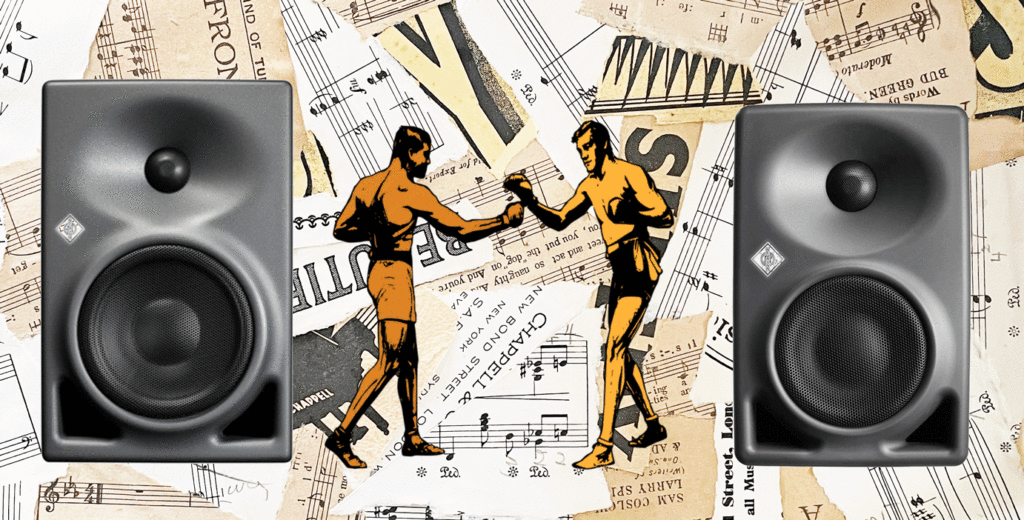
Another speaker in the Neumann KH range is the smaller KH80 DSP. Let’s look at how it compares to the KH 120.
The KH80 DSP is the smaller sibling of the KH 120 A. It’s more compact, with a 4” woofer, a reduced frequency range of 57Hz – 21kHz, and is slightly quieter at 118.8db SPL. The KH 80 shares many design features with the KH 120, including thermo limiters which protect the circuitry from overheating, and threaded inserts for wall-mounting.
One big difference between the KH80 and the KH120, is the inclusion of some of Neumann’s DSP technology. This is used internally to calculate the crossover between woofer and tweeter. It can be also used in conjunction with the “Neumann.Control” app to help calibrate the speakers to the sound of your room. This is definitely a great feature, but unfortunately the app is only currently available for iPad users.
Like its big brother, the KH80 DSP has an extremely flat and neutral frequency response, and offers clear and dynamic sound. Similarly, it handles the crossover between woofer and tweeter without any noticeable artefacts.
The main advantage of the KH80 DSP is the price, retailing at around $100 lower the KH120. If you like the sound of the KH 120, but can’t quite stretch to the budget, or if you have a very small room, the KH 80 could be a great choice.
However, if you can spend a bit more, then it might be worth going for the KH 120 A which offers more power and deeper bass.
Summary
The Neumann KH 120s are built to last, with precision engineering and thoughtful, intelligent design. They offer a remarkably flat and neutral sound which is extremely clear and dynamic. For serious musicians and mix engineers looking to upgrade their setup, the KH 120s should be at the top of your list.
